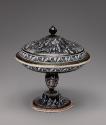
Pierre Reymond était l’un des plus importants émailleurs de Limoges. Cette paire de coupes couvertes fait partie des nombreux émaux produits par Reymond et son atelier. Il est intéressant de voir le mélange de scènes à la fois mythologiques et religieuses. Les scènes principales représentent des personnages importants de l’Ancien Testament : Moïse, David et Salomon. Les scènes secondaires sont des sujets mythologiques. Certaines pièces émaillées semblent posséder un discours anticlérical. C’est notamment le cas de frises représentant le clergé qui dans certains cas porte des oreilles d’âne par exemple. Vous pouvez notamment observer ce motif sur une plaque attribuée au Maître I.C, probablement Jean de Court, et présentée à côté de ces coupes. Les figures bibliques de l’Ancien Testament sont alors perçues comme des sages ce qui est particulièrement intéressant au vu du contexte historique. Au 16e siècle, les guerres de Religion divisent alors le royaume de France. Les artistes y compris ceux sous le patronage du roi et de son entourage font également l’objet de persécutions. Le céramiste Bernard Palissy, un Huguenot, qui aurait participé à la conception de l’aiguière de Saint-Porchaire présentée dans la salle suivante est mort à la Bastille en raison de ses convictions. Nous ne savons pas si Reymond était Huguenot ou Catholique. Il y avait parmi sa clientèle à la fois des Catholiques et Huguenots. Il a sans doute adapté ses sujets en conséquence ou repris des thèmes populaires.
Covered Tazza (One of a Pair)
These tazzas are part of a larger service with arms generally attributed to Pierre Séguier (1504–1580) or one of his relatives. The iconography derives from woodcuts by Bernard Salomon (ca. 1508 or 1510–ca. 1561) that illustrates Les Quadrins historiques de la Bible, first published in 1553. The coats of arms represented are similar to those of the Séguier family, but several elements represented here could suggest the Chabriant de Cornac family. The first tazza, inscribed with Exodus XVI, depicts the Fall of Manna. The decoration inside the lid includes acanthus leaves, arabesques inspired by Jacques Androuet du Cerceau (1510–1584), and four framed scenes drawing on mythological subjects. The interior of the cup depicts Moses and his father-in-law Jethro in a scene from Exodus. Two different scenes are illustrated on the foot: the procession of Amphitrite and Neptune after their union and an episode from Exodus in which Moses strikes a rock that miraculously begins to spout water. The second tazza is similarly decorated. In place of the first tazza's four mythological scenes are four framed winged putti. The exterior of the lid illustrates a scene identified as II Rois XVIII (2 Samuel 18:9–14), the story of Absalom. The interior of the cup—which includes the words III Rois X (1 Kings 10)—depicts the Queen of Sheba in Jerusalem.

















